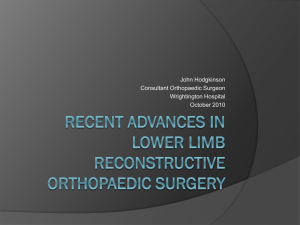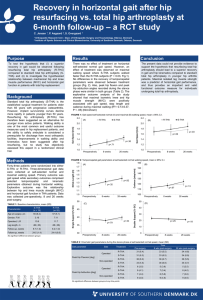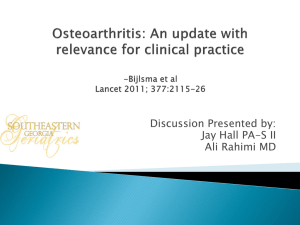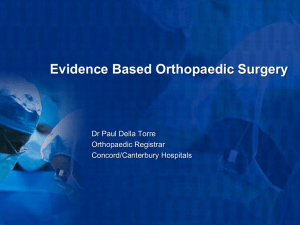References - UT Health Northeast
advertisement
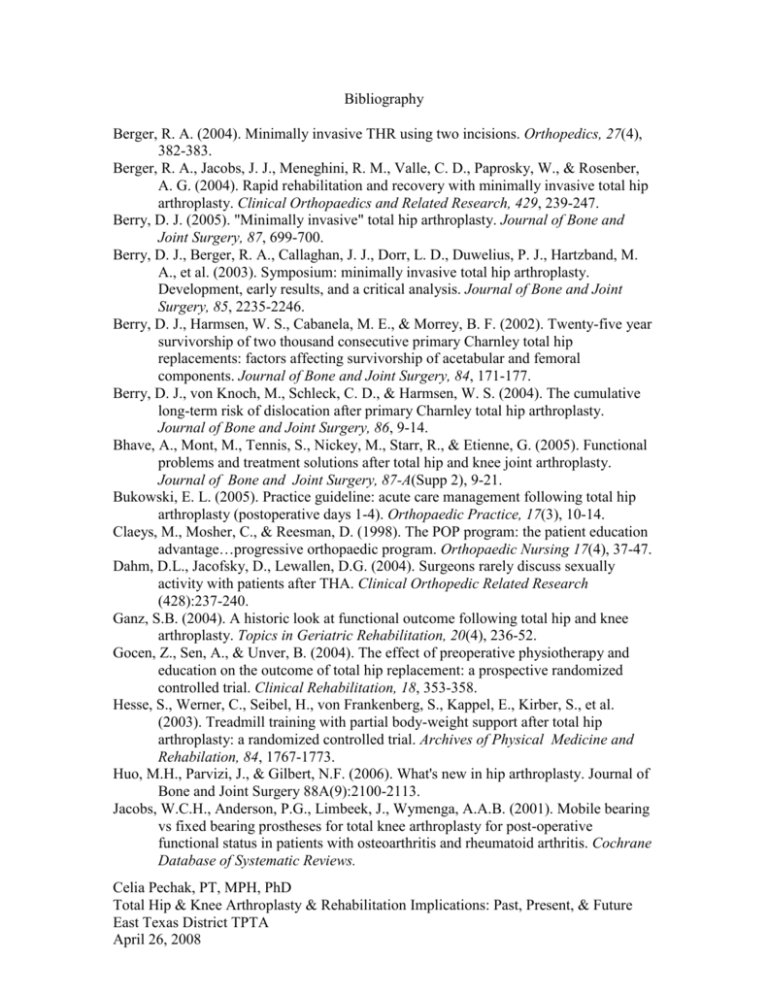
Bibliography Berger, R. A. (2004). Minimally invasive THR using two incisions. Orthopedics, 27(4), 382-383. Berger, R. A., Jacobs, J. J., Meneghini, R. M., Valle, C. D., Paprosky, W., & Rosenber, A. G. (2004). Rapid rehabilitation and recovery with minimally invasive total hip arthroplasty. Clinical Orthopaedics and Related Research, 429, 239-247. Berry, D. J. (2005). "Minimally invasive" total hip arthroplasty. Journal of Bone and Joint Surgery, 87, 699-700. Berry, D. J., Berger, R. A., Callaghan, J. J., Dorr, L. D., Duwelius, P. J., Hartzband, M. A., et al. (2003). Symposium: minimally invasive total hip arthroplasty. Development, early results, and a critical analysis. Journal of Bone and Joint Surgery, 85, 2235-2246. Berry, D. J., Harmsen, W. S., Cabanela, M. E., & Morrey, B. F. (2002). Twenty-five year survivorship of two thousand consecutive primary Charnley total hip replacements: factors affecting survivorship of acetabular and femoral components. Journal of Bone and Joint Surgery, 84, 171-177. Berry, D. J., von Knoch, M., Schleck, C. D., & Harmsen, W. S. (2004). The cumulative long-term risk of dislocation after primary Charnley total hip arthroplasty. Journal of Bone and Joint Surgery, 86, 9-14. Bhave, A., Mont, M., Tennis, S., Nickey, M., Starr, R., & Etienne, G. (2005). Functional problems and treatment solutions after total hip and knee joint arthroplasty. Journal of Bone and Joint Surgery, 87-A(Supp 2), 9-21. Bukowski, E. L. (2005). Practice guideline: acute care management following total hip arthroplasty (postoperative days 1-4). Orthopaedic Practice, 17(3), 10-14. Claeys, M., Mosher, C., & Reesman, D. (1998). The POP program: the patient education advantage…progressive orthopaedic program. Orthopaedic Nursing 17(4), 37-47. Dahm, D.L., Jacofsky, D., Lewallen, D.G. (2004). Surgeons rarely discuss sexually activity with patients after THA. Clinical Orthopedic Related Research (428):237-240. Ganz, S.B. (2004). A historic look at functional outcome following total hip and knee arthroplasty. Topics in Geriatric Rehabilitation, 20(4), 236-52. Gocen, Z., Sen, A., & Unver, B. (2004). The effect of preoperative physiotherapy and education on the outcome of total hip replacement: a prospective randomized controlled trial. Clinical Rehabilitation, 18, 353-358. Hesse, S., Werner, C., Seibel, H., von Frankenberg, S., Kappel, E., Kirber, S., et al. (2003). Treadmill training with partial body-weight support after total hip arthroplasty: a randomized controlled trial. Archives of Physical Medicine and Rehabilation, 84, 1767-1773. Huo, M.H., Parvizi, J., & Gilbert, N.F. (2006). What's new in hip arthroplasty. Journal of Bone and Joint Surgery 88A(9):2100-2113. Jacobs, W.C.H., Anderson, P.G., Limbeek, J., Wymenga, A.A.B. (2001). Mobile bearing vs fixed bearing prostheses for total knee arthroplasty for post-operative functional status in patients with osteoarthritis and rheumatoid arthritis. Cochrane Database of Systematic Reviews. Celia Pechak, PT, MPH, PhD Total Hip & Knee Arthroplasty & Rehabilitation Implications: Past, Present, & Future East Texas District TPTA April 26, 2008 Jacobs, W.C.H., Clement, D.J., & Wymenga, A.B. (2007). Retention versus sacrifice of the posterior cruciate ligamenet in total knee replacement for treatment of osteoarthritis and rheumatoid arthritis. Cochrane Database of Systematic Reviews. Jan, M., Jung, J., Lin, J. C., Wang, S., Liu, T., & Tang, P. (2004). Effects of a home program on strength, walking speed, and function after total hip replacement. Archives of Physical Medicine and Rehabilitation, 85, 1943-1951. Jolles, B.M., & Earl, R.B. (2008). Posterior versus lateral surgical approach for total hip arthroplasty in adults with osteoarthritis. Cochrane Database of Systematic Reviews. Jones, C. A., Beaupre, L. A., Johnston, D. W. C., & Suarez-Almazor, M. E. (2005). Total joint arthroplasties: current concepts of patient outcomes after surgery. Clinical Geriatric Medicine, 21, 527-541. Jones, D.L., Westby, M.D., Greidanus, N., Johanson, N.A., Krebs, D.E., Robbins, L., Rooks, D.S., & Brander, V. (2005). Update on hip and knee arthroplasty: Current state of evidence. Arthritis & Rheumatism, 53(5):772-780. Kennedy, D.M., Stratford, P.W., Riddle, D.L.,Hanna, S.E., & Gollish, J.D. (2008). Assessing recovery and establishing prognosis following total knee arthroplasty. Physical Therapy 88(1):22-32. Khan, R.J.K., Carey Smith, R.L., Alakeson, R. Fick, D.P., & Wood, D. (2008). Operative and non-operative treatment options for dislocation of the hip following total hip arthroplasty. Cochrane Database of Systematic Reviews. King, J., Stamper, D.L., Schaad, D.C., & Leopold, S.S. (2007). Minimally invasive total knee arthroplasty compared with traditional total knee arthroplasty. Assessment of the learning curve and the postoperative recuperative period. Journal of Bone & Joint Surgery 89A(7):1497-1503. Kuster, M. S. (2002). Exercise recommendations after total joint replacement a review of the current literature and proposal of scientifically based guidelines. Sports Medicine, 32(7), 433-445. Lawlor, M., Humphreys, P., & Morrow, E. (2005). Comparison of early postoperative functional levels following total hip replacement using minimally invasive versus standard incisions. A prospective randomized blinded trial. Clinical Rehabilitation, 19, 465-474. Mardones, R., Pagnano, M. W., Nemanich, J. P., & Trousdale, R. T. (2005). Muscle damage after total hip arthroplasty done with the two-incision and mini-posterior techniques. Clinical Orthopaedics and Related Research, 441, 63-67. Milne, S., Brosseau, L., Robinson, V., Noel, M.J., Davis, J., Drouin, H., Wells, G.., & Tugwell, P. (2007). Cochrane Database of Systematic Reviews. Minns Lowe, C.J., Barker, K.L., Dewey, M., Sackley, C.M. (2007). Effectiveness of physiotherapy exercise after knee arthroplasty for osteoarthritis: systematic review and meta-analysis of randomized controlled trials. British Medical Journal 335(7624):812. Moon, L.B. & Backer, J. (2000). Relationships among self-efficacy, outcome expectancy, and postoperative behaviors in total joint replacement patients. Orthopaedic Nursing, 19(2), 77-85. Celia Pechak, PT, MPH, PhD Total Hip & Knee Arthroplasty & Rehabilitation Implications: Past, Present, & Future East Texas District TPTA April 26, 2008 Ogonda, L., Wilson, R., Archbold, P., Lawlor, M., Humphreys, P., O'Brien, S., et al. (2005). A minimal-incision technique in total hip arthroplasty does not improve early postoperative outcomes. Journal of Bone and Joint Surgery, 87-A(4), 701710. Otto, T. J. (2005). Minimally invasive total hip arthroplasty: experience at Saint Louis University. Missouri Medicine, 102(3), 216-220. Pagnano, M. W., Leone, J., Lewallen, D. G., & Hanssen, A. D. (2005). Two-incision THA had modest outcomes and some substantial complications. Clinical Orthopaedics and Related Research, 441, 86-90. Peak, E. L., Parvisi, J., Ciminiello, M., Purtill, J. J., Sharkey, P. F., Hozack, W. J., et al. (2005). The role of patient restrictions in reducing the prevalence of early disclocation following total hip arthroplasty. A randomized, prospective study. Journal of Bone and Joint Surgery Am, 87, 247-253. Petterson, S.C, & Snyder-Mackler, L. (2006). Strength and functional outcomes in unilateral versus simultaneous bilateral total knee arthroplasty. Journal of Geriatric Physical Therapy 29(3):127. Rea, B.L., Marshak, H.H., Neish, C., & Davis, N. (2004). The role of health promotion in physical therapy in California, New York, and Tennessee. Physical Therapy 84(6), 510-523. Roberts, V.I., Esler, C.N.A., & Harper, W.M. (2007). A 15-year follow up study of 4606 primary total knee replacements. Journal of Bone & Joint Surgery 89B(11):14521456. Schoderbek, R.J., Brown, T.E., Mulhall, K.J., Mounasamy, V., Iorio, R., Krackow, K.A., Macaulay, W., & Saleh, K.J. (2006). Extensor mechanism disruption after total knee arthroplasty. Clinical Orthopaedics & Related Research, May(446):176-185. Singelyn, F. J., Ferrant, T., Malisse, M. F., & Joris, D. (2005). Effects of intravenous patient-controlled analgesia with morphine, continuous epidural analgesia, and continuous femoral nerve sheath block on rehabilitation after unilateral total-hip arthroplasty. Regional Anesthesia and Pain Medicine, 30(5), 452-457. Talbot, N. J., Brown, J. H., & Treble, N. J. (2002). Early dislocation after total hip arthroplasty: are postoperative restrictions necessary? Journal of Arthroplasty 17(8), 1006-1008. Thompson, S.R., Sterling, R.S., & O'Briend, M.J. (2008). Total knee arthroplasty in obese patients. Current Opinion in Orthopaedics 19(1):68-71. Trudelle-Jackson, E., & Smith, S. S. (2004). Effects of a later-phase exercise program after total hip arthroplasty: a randomized controlled trial. Archives of Physical Medicine and Rehabilitation, 85, 1056-1062. Vincent, H.K., & Vincent, K.R. (2007). Influence of admission hematocrit on inpatient rehabilitation outcomes after total knee and hip arthroplasty. American Journal of Physical Medicine and Rehabilitation 86(10):806-817. von Knoch, M., Berry, D. J., Harmsen, W. S., & Morrey, B. F. (2002). Late dislocation after total hip arthroplasty. Journal of Bone and Joint Surgery, 84-A(11), 19491953. Celia Pechak, PT, MPH, PhD Total Hip & Knee Arthroplasty & Rehabilitation Implications: Past, Present, & Future East Texas District TPTA April 26, 2008 Walker, W. C., Keyser-Marcus, L. A., Cifu, D. X., & Chaudri, M. (2001). Inpatient interdisciplinary rehabilitation after total hip arthroplasty surgery: a comparison of revision and primary total hip arthroplasty. Archives of Physical Medicine and Rehabilitation, 82, 129-133. Wenz, J. F., Gurkan, I., Jibodh, S. R. (2002). Mini-incision total hip arthroplasty: a comparative assessment of perioperative outcomes. Orthopedics, 25(10), 10311043. White, S. C., & Lifeso, R. M. (2005). Altering asymmetric limb loading after hip arthroplasty using real-time dynamic feedback when walking. Archives of Physical Medicine and Rehabilitation, 86, 1958-1963. Woolson, S. T., & Adler, N. S. (2002). The effect of partial or full weight bearing ambulation after cementless total hip arthroplasty. Journal of Arthroplasty, 17(7), 820-825. Woolson, S. T., Mow, C. S., Syquia, J. F., Lannin, J. V., & Schurman, D. J. (2004). Comparison of primary total hip replacements performed with a standard incision or mini-incision. Journal of Bone and Joint Surgery, 86-A(7), 1353-1358. Woolson, S. T., & Rahimtoola, Z. O. (1999). Risk factors for dislocation during the first 3 months after primary total hip replacement. Journal of Arthroplasty, 14(6), 662-668. Celia Pechak, PT, MPH, PhD Total Hip & Knee Arthroplasty & Rehabilitation Implications: Past, Present, & Future East Texas District TPTA April 26, 2008



